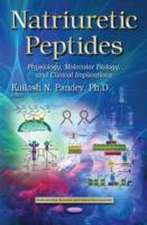Growth Hormone Secretagogues: Basic Findings and Clinical Implications
Editat de E. Ghigo, M. Boghen, Felipe F. Casanueva, C. Dieguezen Limba Engleză Hardback – 7 sep 1999
There was an enthusiastic response from experts in this area to the idea of distilling the huge amount of available data into one multi-authored volume. Each contributor has advanced the field of knowledge, and has here emphasized the practical aspects of their work, reviewing the subject in the light of their own experience. Therefore, the theme of the book is a practical one.
The volume deals with all aspects of GHS that are relevant to the field, from the chemical structure to the different analogues, to the cloning and expression of the GHS-receptor and the role of these compounds in the physiological control of GH secretion. Also discussed are the most recent advances in relation to the possible role of these compounds in the diagnostic therapeutic settings in different clinical situations, either in children, adults or the elderly.
The book meets the requirement of covering most, if not all of the advances in the field. It will enable scientists and clinicians to keep abreast of the rapidly evolving knowledge of the most recent years, and will also prove useful as a review for all interested in this topic.
Preț: 1152.90 lei
Preț vechi: 1213.58 lei
-5% Nou
Puncte Express: 1729
Preț estimativ în valută:
220.65€ • 229.75$ • 186.47£
220.65€ • 229.75$ • 186.47£
Carte tipărită la comandă
Livrare economică 10-24 martie
Preluare comenzi: 021 569.72.76
Specificații
ISBN-13: 9780444829337
ISBN-10: 0444829334
Pagini: 325
Ilustrații: 1
Dimensiuni: 156 x 234 x 21 mm
Greutate: 0.65 kg
Editura: ELSEVIER SCIENCE
ISBN-10: 0444829334
Pagini: 325
Ilustrații: 1
Dimensiuni: 156 x 234 x 21 mm
Greutate: 0.65 kg
Editura: ELSEVIER SCIENCE
Cuprins
Prologue. Contributing Authors. Chapter 1. Introduction (S.W.J. Lamberts). Chapter 2. GHRP : Unnatural toward the natural (C.Y. Bowers). Chapter 3. Impervious peptides as GH secretagogues (R. Deghenghi). Chapter 4. GHRP Structure -activity relationship: an in vivo perspective (R. Clark).
Chapter 5. Molecular analysis of the growth hormone secretagogue receptor (A.D. Howard, S.-S. Pong, K.K. McKee, O.C. Palyha, D.L. Hreniuk, C.P. Tan, R. Nargund, A.A. Patchett, L.H.T Van Der Ploeg, R.G. Smith, S.D. Feighner). Chapter 6. Intracellular GHRP signalling (C. Chen, I.J. Clarke). Chapter 7. The effects of GH-secretagogues on human pituitary cells in culture and on rat hypothalamic tissue (M. Korbonits, E.F. Adams, A.B. Grossman). Chapter 8. Hypothalamic site and mechanism of action of growth hormone secretagogues (S.L. Dickson). Chapter 9. Mechanisms of actions of growth hormone-releasing peptides and their analogues in vivo (C. Oliver, F. Dadoun, N. Briard, V. Guillaume, N. Sauze, M. Grino, A. Dutour). Chapter 10. Animal models of growth hormone deficiency as tools to study growth hormone releasing mechanisms (L.A. Frohman, R.D. Kineman). Chapter 11. Regulation of growth hormone (GH) pulsatility in humans (E.V. Dimaraki, A.L. Barkan). Chapter 12. Hormonal activities of growth hormone secretagogues (GHS) across human lifespan (E. Arvat, F. Broglio, R. Giordano, G. Muccioli, M. Maccario, F. Camanni, E. Ghigo). Chapter 13. Effectiveness of growth hormone secretagogues in the diagnosis and treatment of GH secretory deficiency (B.B. Bercu, R.F. Walker). Chapter 14. Does desensitisation to growth hormone secretagogues occur? (A. Rahim, S.M. Shalet). Chapter 15. GHRPs in human obesity (J. Svensson, J.-O. Jansson, B.-Å Bengtsson). Chapter 16. Effects of growth hormone secretagogues on in vivo substrate metabolism in humans (N. Møller, J.O. Jorgensen, J.S. Christiansen). Chapter 17. Growth hormone secretagogues. Physiological role and clinical implications (C. Dieguez, V. Popovic, D. Micic, A. Leal-Cerro, A. Penalva, R.V. Garcia-Mayor, M. Pombo, F.F. Casanueva). Chapter 18. Growth hormone secretagogues in critical illness (G.H.A. Van Den Berghe). Chapter 19. Growth hormone secretagogues in catabolic illness (R.C. Jenkins, R.J.M. Ross).
Chapter 20. Treatment of children with short stature by growth hormone secretagogues (Z. Laron).
Chapter 21. Therapeutic potential of GH secretagogues in adults (R.M. Nass, M.O. Thorner). Chapter 22. Growth hormone secretagogue influences feeding behaviour in experimental animals (I. Wakabayashia, H. Sugihara, T. Shibasaki). Chapter 23. Growth hormone secretagogues and sleep ( A. Steiger). Chapter 24. Hexarelin, a synthetic growth hormone secretagogue, exhibits protectant activity in experimental myocardial ischemia and reperfusion (F. Berti, G. Rossoni, V. De Gennaro Colonna). Chapter 25. Potential applications of growth hormone secretagogues (I. Shimon, S. Melmed). Index.
Chapter 5. Molecular analysis of the growth hormone secretagogue receptor (A.D. Howard, S.-S. Pong, K.K. McKee, O.C. Palyha, D.L. Hreniuk, C.P. Tan, R. Nargund, A.A. Patchett, L.H.T Van Der Ploeg, R.G. Smith, S.D. Feighner). Chapter 6. Intracellular GHRP signalling (C. Chen, I.J. Clarke). Chapter 7. The effects of GH-secretagogues on human pituitary cells in culture and on rat hypothalamic tissue (M. Korbonits, E.F. Adams, A.B. Grossman). Chapter 8. Hypothalamic site and mechanism of action of growth hormone secretagogues (S.L. Dickson). Chapter 9. Mechanisms of actions of growth hormone-releasing peptides and their analogues in vivo (C. Oliver, F. Dadoun, N. Briard, V. Guillaume, N. Sauze, M. Grino, A. Dutour). Chapter 10. Animal models of growth hormone deficiency as tools to study growth hormone releasing mechanisms (L.A. Frohman, R.D. Kineman). Chapter 11. Regulation of growth hormone (GH) pulsatility in humans (E.V. Dimaraki, A.L. Barkan). Chapter 12. Hormonal activities of growth hormone secretagogues (GHS) across human lifespan (E. Arvat, F. Broglio, R. Giordano, G. Muccioli, M. Maccario, F. Camanni, E. Ghigo). Chapter 13. Effectiveness of growth hormone secretagogues in the diagnosis and treatment of GH secretory deficiency (B.B. Bercu, R.F. Walker). Chapter 14. Does desensitisation to growth hormone secretagogues occur? (A. Rahim, S.M. Shalet). Chapter 15. GHRPs in human obesity (J. Svensson, J.-O. Jansson, B.-Å Bengtsson). Chapter 16. Effects of growth hormone secretagogues on in vivo substrate metabolism in humans (N. Møller, J.O. Jorgensen, J.S. Christiansen). Chapter 17. Growth hormone secretagogues. Physiological role and clinical implications (C. Dieguez, V. Popovic, D. Micic, A. Leal-Cerro, A. Penalva, R.V. Garcia-Mayor, M. Pombo, F.F. Casanueva). Chapter 18. Growth hormone secretagogues in critical illness (G.H.A. Van Den Berghe). Chapter 19. Growth hormone secretagogues in catabolic illness (R.C. Jenkins, R.J.M. Ross).
Chapter 20. Treatment of children with short stature by growth hormone secretagogues (Z. Laron).
Chapter 21. Therapeutic potential of GH secretagogues in adults (R.M. Nass, M.O. Thorner). Chapter 22. Growth hormone secretagogue influences feeding behaviour in experimental animals (I. Wakabayashia, H. Sugihara, T. Shibasaki). Chapter 23. Growth hormone secretagogues and sleep ( A. Steiger). Chapter 24. Hexarelin, a synthetic growth hormone secretagogue, exhibits protectant activity in experimental myocardial ischemia and reperfusion (F. Berti, G. Rossoni, V. De Gennaro Colonna). Chapter 25. Potential applications of growth hormone secretagogues (I. Shimon, S. Melmed). Index.
Recenzii
from:(R. Dantzer, Integrative Neurobiology, INRA-INSERM U394, France)
"The book...illustrates very well the thrust of research in this area thanks to 25 multi-authored chapters covering a wide range of existing data, from the chemical structure of the different analogues to the cloning and expression of the GHS-receptor and the role of these compounds in the physiological control of GH secretion." --Psychoneuroendocrinology, Vol. 26
"The book...illustrates very well the thrust of research in this area thanks to 25 multi-authored chapters covering a wide range of existing data, from the chemical structure of the different analogues to the cloning and expression of the GHS-receptor and the role of these compounds in the physiological control of GH secretion." --Psychoneuroendocrinology, Vol. 26

























